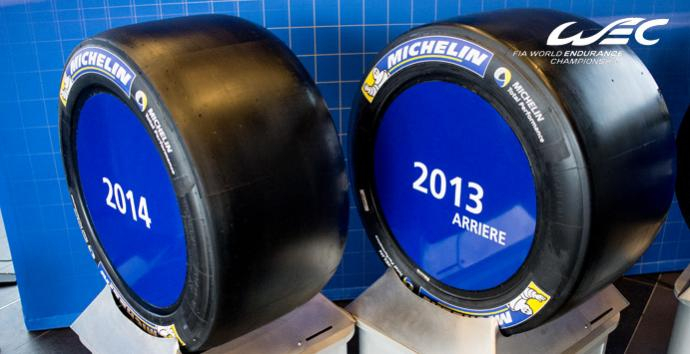FromFrom 2014, the LMP1 prototypes competing in the FIA World Endurance Championship (WEC) will race on new MICHELIN tyres (31/71-18). These new covers will replace the 36/71-18 (front) and 37/71-18 (rear) tyres used in the discipline’s premier class at the moment. Although significantly narrower and lighter (weight saving: 4kg per set), the new solutions will deliver a level of performance, consistency and longevity adapted to the new, 2014-generation LMP1 prototypes.
Endurance racing’s governing bodies have approved the new regulations for 2014. In addition to being particularly ambitious on the technical front, they are also geared to the promotion of sustainable mobility. They establish new ground rules for car design, while the bid for greater energy efficiency has had a significant influence on the development of the tyres these new prototypes will use.
MICHELIN has worked closely with its partners in order to rise to this new technological challenge which consists in making maximum use of a given quantity of energy during every lap.
By working in perfect harmony with the cars’ suspensions, tyres play an active part in the prototypes’ efficiency. Not only do they need to support the weight of the car, but they must also be capable of handling the colossal aerodynamic downforce they generate (which can represent up to three times the car’s own weight!), not to mention extremely high levels of lateral and longitudinal acceleration. Under braking, for example, the force exerted under deceleration can reach as high as 3g, whereas the lateral force recorded through the Porsche Curves at Le Mans can be close to 3.5g. MICHELIN consequently strives to perfect how the cars and their tyres work together.
The French tyre manufacturer benefits from specific expertise in the field of advanced energy-efficient tyres thanks to the Group’s involvement in high-profile motorsport, as Serge GRISIN, the manager of Michelin’s car racing programmes, explains: “Throughout the last few seasons of endurance racing, MICHELIN has considerably enhanced the longevity of its tyres. At the same time, in keeping with the MICHELIN Total Performance strategy, which consists in working globally on all the factors that influence tyre performance, even those considered by some to be irreconcilable, we have achieved this result while also maintaining the same high standards of safety and performance.”
For example, the winning Audi R18 at Le Mans in 2011 completed 750 kilometres – the equivalent of five stints – on the same set of tyres. In 2012, the Group used advanced modelling tools to successfully design narrow, lightweight tyres for the NISSAN DeltaWing, and this allowed us to acquire significant technical expertise in the field of the ratio between tyre size and performance. This year, MICHELIN is using this experience to work on the FIA’s new regulations which will be enforced in the WEC from 2014.
Using all their experience of designing tyres for LMP1 prototypes, as well as the expertise acquired during the NISSAN DeltaWing project, the firm’s developers designed the new 31/71-18 tyres with the help of simulation tools.
Validation testing began in April 2013, in association with AUDI Sport Team Joest. MICHELIN’s German partner will also run a prototype equipped with new tyres on June 9, during the 2013 Le Mans 24 Hours Test Day. Test programmes with MICHELIN’s other LMP1 partners are scheduled for the coming months at a variety of circuits, in Europe and elsewhere.
It is important to note that the new size for the forthcoming LMP1 prototypes (31/71-18) is equivalent to a 335/35ZR18 road tyre. This parallel will further streamline the transfer of technology from track to road.
From Michelin press release
2014, the LMP1 prototypes competing in the FIA World Endurance Championship (WEC) will race on new MICHELIN tyres (31/71-18). These new covers will replace the 36/71-18 (front) and 37/71-18 (rear) tyres used in the discipline’s premier class at the moment. Although significantly narrower and lighter (weight saving: 4kg per set), the new solutions will deliver a level of performance, consistency and longevity adapted to the new, 2014-generation LMP1 prototypes.
Endurance racing’s governing bodies have approved the new regulations for 2014. In addition to being particularly ambitious on the technical front, they are also geared to the promotion of sustainable mobility. They establish new ground rules for car design, while the bid for greater energy efficiency has had a significant influence on the development of the tyres these new prototypes will use.
MICHELIN has worked closely with its partners in order to rise to this new technological challenge which consists in making maximum use of a given quantity of energy during every lap.
By working in perfect harmony with the cars’ suspensions, tyres play an active part in the prototypes’ efficiency. Not only do they need to support the weight of the car, but they must also be capable of handling the colossal aerodynamic downforce they generate (which can represent up to three times the car’s own weight!), not to mention extremely high levels of lateral and longitudinal acceleration. Under braking, for example, the force exerted under deceleration can reach as high as 3g, whereas the lateral force recorded through the Porsche Curves at Le Mans can be close to 3.5g. MICHELIN consequently strives to perfect how the cars and their tyres work together.
The French tyre manufacturer benefits from specific expertise in the field of advanced energy-efficient tyres thanks to the Group’s involvement in high-profile motorsport, as Serge GRISIN, the manager of Michelin’s car racing programmes, explains: “Throughout the last few seasons of endurance racing, MICHELIN has considerably enhanced the longevity of its tyres. At the same time, in keeping with the MICHELIN Total Performance strategy, which consists in working globally on all the factors that influence tyre performance, even those considered by some to be irreconcilable, we have achieved this result while also maintaining the same high standards of safety and performance.”
For example, the winning Audi R18 at Le Mans in 2011 completed 750 kilometres – the equivalent of five stints – on the same set of tyres. In 2012, the Group used advanced modelling tools to successfully design narrow, lightweight tyres for the NISSAN DeltaWing, and this allowed us to acquire significant technical expertise in the field of the ratio between tyre size and performance. This year, MICHELIN is using this experience to work on the FIA’s new regulations which will be enforced in the WEC from 2014.
Using all their experience of designing tyres for LMP1 prototypes, as well as the expertise acquired during the NISSAN DeltaWing project, the firm’s developers designed the new 31/71-18 tyres with the help of simulation tools.
Validation testing began in April 2013, in association with AUDI Sport Team Joest. MICHELIN’s German partner will also run a prototype equipped with new tyres on June 9, during the 2013 Le Mans 24 Hours Test Day. Test programmes with MICHELIN’s other LMP1 partners are scheduled for the coming months at a variety of circuits, in Europe and elsewhere.
It is important to note that the new size for the forthcoming LMP1 prototypes (31/71-18) is equivalent to a 335/35ZR18 road tyre. This parallel will further streamline the transfer of technology from track to road.

